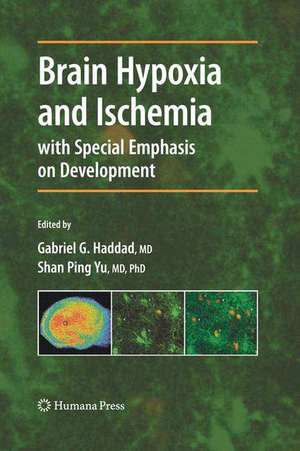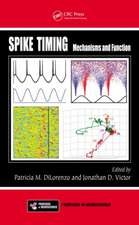Brain Hypoxia and Ischemia: Contemporary Clinical Neuroscience
Editat de Gabriel G. Haddad, Shan Ping Yuen Limba Engleză Hardback – 12 dec 2008
This volume aims to increase the understanding of these mechanisms and to stimulate research on better diagnosis and treatment of diseases that afflict the brain and potentially other organs when O2 levels are dysregulated. Brain Hypoxia and Ischemia is designed for neuroscientists, clinicians and medical/graduate students for use in both basic research and clinical practice.
| Toate formatele și edițiile | Preț | Express |
|---|---|---|
| Paperback (1) | 1274.90 lei 6-8 săpt. | |
| Humana Press Inc. – 9 dec 2010 | 1274.90 lei 6-8 săpt. | |
| Hardback (1) | 1225.94 lei 6-8 săpt. | |
| Humana Press Inc. – 12 dec 2008 | 1225.94 lei 6-8 săpt. |
Din seria Contemporary Clinical Neuroscience
- 5%
 Preț: 655.43 lei
Preț: 655.43 lei - 18%
 Preț: 958.25 lei
Preț: 958.25 lei - 18%
 Preț: 1678.01 lei
Preț: 1678.01 lei - 18%
 Preț: 1403.22 lei
Preț: 1403.22 lei - 18%
 Preț: 1008.43 lei
Preț: 1008.43 lei - 5%
 Preț: 1407.87 lei
Preț: 1407.87 lei - 18%
 Preț: 1101.40 lei
Preț: 1101.40 lei - 18%
 Preț: 944.19 lei
Preț: 944.19 lei - 18%
 Preț: 1231.01 lei
Preț: 1231.01 lei - 5%
 Preț: 1105.95 lei
Preț: 1105.95 lei - 15%
 Preț: 644.30 lei
Preț: 644.30 lei - 5%
 Preț: 1173.82 lei
Preț: 1173.82 lei - 15%
 Preț: 641.03 lei
Preț: 641.03 lei - 18%
 Preț: 1239.19 lei
Preț: 1239.19 lei - 18%
 Preț: 1229.40 lei
Preț: 1229.40 lei - 18%
 Preț: 1110.24 lei
Preț: 1110.24 lei - 18%
 Preț: 1113.39 lei
Preț: 1113.39 lei - 5%
 Preț: 1438.58 lei
Preț: 1438.58 lei - 15%
 Preț: 651.84 lei
Preț: 651.84 lei - 5%
 Preț: 1103.22 lei
Preț: 1103.22 lei - 18%
 Preț: 1402.55 lei
Preț: 1402.55 lei - 5%
 Preț: 1089.48 lei
Preț: 1089.48 lei - 18%
 Preț: 1828.60 lei
Preț: 1828.60 lei - 5%
 Preț: 1103.75 lei
Preț: 1103.75 lei - 18%
 Preț: 1407.46 lei
Preț: 1407.46 lei - 18%
 Preț: 951.47 lei
Preț: 951.47 lei - 18%
 Preț: 1385.37 lei
Preț: 1385.37 lei
Preț: 1225.94 lei
Preț vechi: 1495.04 lei
-18% Nou
Puncte Express: 1839
Preț estimativ în valută:
234.62€ • 244.04$ • 193.69£
234.62€ • 244.04$ • 193.69£
Carte tipărită la comandă
Livrare economică 14-28 aprilie
Preluare comenzi: 021 569.72.76
Specificații
ISBN-13: 9781603275781
ISBN-10: 1603275789
Pagini: 376
Ilustrații: XII, 268 p. 47 illus., 26 illus. in color.
Dimensiuni: 155 x 235 x 29 mm
Greutate: 0.68 kg
Ediția:2009
Editura: Humana Press Inc.
Colecția Humana
Seria Contemporary Clinical Neuroscience
Locul publicării:Totowa, NJ, United States
ISBN-10: 1603275789
Pagini: 376
Ilustrații: XII, 268 p. 47 illus., 26 illus. in color.
Dimensiuni: 155 x 235 x 29 mm
Greutate: 0.68 kg
Ediția:2009
Editura: Humana Press Inc.
Colecția Humana
Seria Contemporary Clinical Neuroscience
Locul publicării:Totowa, NJ, United States
Public țintă
Professional/practitionerCuprins
Ion Channels, Transporters and Excitotoxicity.- Regulation of Vulnerability to NMDA Excitotoxicity During Postnatal Maturation.- Acidosis, Acid-Sensing Ion Channels, and Glutamate Receptor-Independent Neuronal Injury.- Brain Ischemia and Neuronal Excitability.- Critical Roles of the Na+/K+-ATPase in Apoptosis and CNS Diseases.- Emerging Role of Water Channels in Regulating Cellular Volume During Oxygen Deprivation and Cell Death.- A Zinc—Potassium Continuum in Neuronal Apoptosis.- Mitochondrial Ion Channels in Ischemic Brain.- Reactive Oxygen Species, and Gene Expression to Behavior.- Perinatal Panencephalopathy in Premature Infants: Is It Due to Hypoxia-Ischemia?.- Effects of Intermittent Hypoxia on Neurological Function.- Brainstem Sensitivity to Hypoxia and Ischemia.- Matrix Metalloproteinases in Cerebral Hypoxia-Ischemia.- Oxidative Stress in Hypoxic-Ischemic Brain Injury.- Postnatal Hypoxia and the Developing Brain: Cellular and Molecular Mechanisms of Injury.- Hypoxia-Inducible Factor 1.- Transcriptional Response to Hypoxia in Developing Brain.- Acute Stroke Therapy: Highlighting the Ischemic Penumbra.- Genes and Survival to Low O2 Environment: Potential Insights from Drosophila.
Textul de pe ultima copertă
Brain Hypoxia and Ischemia
Gabriel G. Haddad, M.D. and Shan Ping Yu, M.D., Ph.D., Editors
Brain Hypoxia and Ischemia explores the various aspects of cell death and survival that are crucial for understanding the basic mechanisms underlying brain hypoxia and ischemia. Chapters focus on a panorama of issues including the role of ion channels/transporters, mitochondria and apoptotic mechanisms, the roles of glutamate/NMDA, mechanisms in penumbral cells and the importance of intermittent hypoxia and gene regulation under these stressful conditions. The volume explores findings from both mammalian and invertebrate model systems and their applicability to human systems and diseases. Careful consideration is also given to differences in hypoxia and ischemia across development.
This volume aims to increase the understanding of these mechanisms and to stimulate research on better diagnosis and treatment of diseases that afflict the brain and potentially other organs when O2 levels are dysregulated. Brain Hypoxia and Ischemia is designed for neuroscientists, clinicians and medical/graduate students for use in both basic research and clinical practice.
Gabriel G. Haddad, M.D. is Professor of Pediatrics and Neuroscience and Chair of the Department of Pediatrics at the University of California, San Diego. He is also Physician-in-Chief at Rady Children’s Hospital in San Diego.
Shan Ping Yu, M.D., Ph.D. is Professor of Anesthesiology at Emory University in Atlanta, GA.
Gabriel G. Haddad, M.D. and Shan Ping Yu, M.D., Ph.D., Editors
Brain Hypoxia and Ischemia explores the various aspects of cell death and survival that are crucial for understanding the basic mechanisms underlying brain hypoxia and ischemia. Chapters focus on a panorama of issues including the role of ion channels/transporters, mitochondria and apoptotic mechanisms, the roles of glutamate/NMDA, mechanisms in penumbral cells and the importance of intermittent hypoxia and gene regulation under these stressful conditions. The volume explores findings from both mammalian and invertebrate model systems and their applicability to human systems and diseases. Careful consideration is also given to differences in hypoxia and ischemia across development.
This volume aims to increase the understanding of these mechanisms and to stimulate research on better diagnosis and treatment of diseases that afflict the brain and potentially other organs when O2 levels are dysregulated. Brain Hypoxia and Ischemia is designed for neuroscientists, clinicians and medical/graduate students for use in both basic research and clinical practice.
Gabriel G. Haddad, M.D. is Professor of Pediatrics and Neuroscience and Chair of the Department of Pediatrics at the University of California, San Diego. He is also Physician-in-Chief at Rady Children’s Hospital in San Diego.
Shan Ping Yu, M.D., Ph.D. is Professor of Anesthesiology at Emory University in Atlanta, GA.
Caracteristici
Most up-to-date volume to focus on the mechanisms of cell injury and cell survival in the brain, with special emphasis on development and early life, in relation to hypoxia and ischemia in the brain. Comments on the developmental stages of the brain is the major societal and economic burden of the affliction when it occurs in early life.














